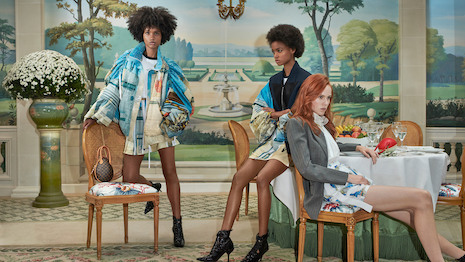- About
- Subscribe Now
- New York,
April 17, 2019

 LVMH sales grew more than 17 percent in fiscal year 2017. Image credit: Louis Vuitton
LVMH sales grew more than 17 percent in fiscal year 2017. Image credit: Louis Vuitton
Ten of the world’s leading luxury companies accounted for almost half of global luxury goods spending in the last fiscal year, as the overall industry grew more than 10 percent despite slowing economies in China, the United States and Europe.
According to Deloitte’s 2019 “Global Powers of Luxury Goods” report, French companies are the biggest contributors to worldwide luxury good sales. Although the clothing and footwear sector is the most represented within the luxury business, personal care and fragrance companies enjoyed the greatest sales growth.
“Companies are committing to make significant investments in stimulating the interest of the younger segments of the population, namely millennials and Gen Z,” said Patrizia Arienti, EMEA fashion and luxury leader at Deloitte, Milan. “Since these ‘new’ tech-savvy generations look for individualized, seamless brand relationship, brands are investing worldwide to market digitally, increasingly using social media to engage with these consumers.
“Meanwhile, companies are also re-examining the value of brand heritage and brand history for their customers,” she said. “Consumer demand has become the core focus of the business, hence the adoption of an omnipersonal approach, irrespective of the choice of channel.”
Deloitte’s report is based on luxury companies’ publicly available data for fiscal year 2017, defined as financial years ending within the 12 months to June 2018. The minimum revenue threshold for a luxury goods company to be considered was $218 million and the top 100 companies averaged revenue of $2.47 billion.
Growth across the board
The top 100 luxury goods companies saw their sales increase an average of 10.8 percent in the 2017 fiscal year, but the top 10 companies performed even better with an average sales jump of 14.2 percent.
Seven of the top 10 luxury companies had double-digit sales growth. Last year the luxury business saw more modest growth, with a sales increase of 1.0 percent.
Kering had sales growth of more than 27 percent last year. Image credit: Bottega Veneta
French luxury conglomerate LVMH Moët Hennessy Louis Vuitton recorded $27.9 billion in sales for a growth of 17.2 percent. As in 2016, beauty group The Estée Lauder Companies Inc. and Swiss conglomerate Richemont rounded out the top three luxury companies in terms of sales.
With sales growth of 27.5 percent, French luxury conglomerate Kering had the largest sales boost among the top 10 luxury companies with sales of $12.2 billion.
All together, the top 10 companies earned $118.9 billion, accounting for 48.2 percent of the luxury industry’s total sales of $246.6 billion.
Deloitte also analyzed luxury sales from a geographic perspective. Companies were designated to a country based on headquarter location.
Seven French companies accounted for almost a quarter of all luxury good sales with an average of $8.3 billion. These companies also averaged sales growth of 18.7 percent, surpassing all other countries.
Luxury companies in China, including Hong Kong, and Japan averaged double-digit sales growth, respectively rising 13.8 and 14.1 percent. Combined, Chinese and Japanese luxury companies make up less than 13 percent of the share of luxury good sales.
Hong Kong’s Chow Tai Fook Jewellery Group Limited led all Asian luxury companies with $7.8 billion in sales. The conglomerate recorded sales growth of 15.4 percent.
Italy is the most represented country in the rankings, with its 24 luxury goods companies responsible for 14 percent of global sales. In 2017, Italian luxury companies' average sales growth was 2.2 percent.
Reflecting the overall luxury business' health, every product sector saw growth in 2017.
Ten companies that sell luxury goods in multiple products sectors, including LVMH and Chanel, accounted for 30.7 percent of global luxury sales with a 15.9 percent increase in sales.
The luxury cosmetics sector saw the highest growth in sales. Image credit: Estée Lauder
While almost four in 10 luxury companies primarily sell clothing and footwear, the sector is responsible for less than 20 percent of all global sales.
Luxury cosmetic and fragrance companies saw the greatest sales growth, 16.1 percent, and accounted for 16.4 percent of worldwide luxury sales. Bag and accessory companies saw the most modest sales growth at 1.5 percent.
Global outlook
While 2018 numbers for luxury brands did not hit the high marks that analysts were expecting, 2019 is poised to be a positive year for the business.
This month’s Savigny Luxury Index reveals that luxury brands who had a dip in numbers in 2018 such as Tiffany, Ferragamo, Tod’s and Prada are expected to have a positive 2019, with Ferragamo already seeing growth in same-store sales. While Tiffany is focusing on growing its ecommerce business, leaving investors hopeful, Hermès is continuing its strong performance thanks to demand in China (see story).
Luxury consumers are also optimistic about 2019.
Despite geopolitical uncertainty and tensions, a report from Knight Frank shows the population of ultra-high-net-worth individuals is projected to rise 22 percent over the next five years.
Some have forecast a slowdown in 2019 or 2020, but there is still a positive outlook for wealth creation. The global population of affluent individuals with assets of at least $1 million is projected to surpass 20 million for the first time in 2019 (see story).
“Luxury brands have started to initiate and sustain longstanding relationships with a new consumer class who is likely to become or remain affluent or ultra-affluent in the future,” Deloitte’s Ms. Arienti said.
Share your thoughts. Click here